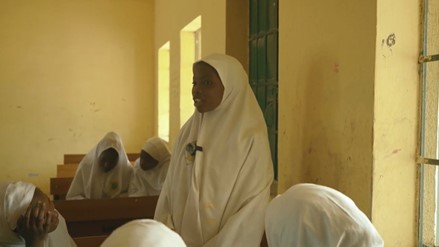OER 2 Using all languages for learning
| Site: | OpenLearn Create |
| Course: | English Medium Education and Gender Equality (EMEGen) Open Educational Resources |
| Book: | OER 2 Using all languages for learning |
| Printed by: | Guest user |
| Date: | Sunday, 23 November 2025, 9:14 AM |
1 Languages, communication and learning
Around the world, it is normal to switch between different languages and dialects. Many people do this spontaneously and without thinking, in their homes and communities.
Alternating between languages or dialects is commonplace in conversations, texting and informal emailing. Here are some examples:
Hum kya kar rahe haim is none of your business. (Hindi + English)
(What we are doing is none of your business.)
Mendapatkan burger dengan saya? (Indonesian Bahasa + English + Indonesian Bahasa)
(Get a burger with me?)
Bugün cuma, isn’t it? (Turkish + English)
(It’s Friday, isn’t it?)
Lakini honestly mtu yeyote anatoka Kenya, as in tuko tu ile like, tuko spontaneous…tuna…we take it as it come. (Kiswahili + English + Kiswahili + English)
(But honestly any person who comes from Kenya, we just like, we are spontaneous, we… we take it as it comes)
This kind of language mixing includes alternating between a standard form of a language and a dialect, or between formal language and informal or ‘slang’ expressions.
Can you think of examples that you see or hear yourself, with friends, family members, or in your community? When and why do you switch between languages?


How do you think this can improve communication between people?
1.1 Languages and learning
In classrooms today, there are students from different language backgrounds who are at different levels of learning the language of school instruction. In some contexts, it is permitted to use a mixture of languages in the classroom, such as the official language of instruction and the local languages of students and teachers.
According to global research evidence (see OER 1 resources), this can support students’ language learning and subject learning at the same time. This can also help the teacher to communicate effectively and clearly.
Translanguaging activity
Allow around 10 minutes
1. Read the following example, notice the link between languages, communication and learning.
In a maths class there are students from six different language groups and the teacher does not speak all the languages of the students. The formal language of instruction is English.
The teacher was teaching a lesson on how to find the volume of three-dimensional shapes.
The teacher first reviewed vocabulary: volume, cone, prism, and cylinder, and then held up objects and asked students, ‘What is this?’ and ‘What are some examples of these in real life?’
For each object, the teacher asked students with different languages how to say the word in their language and to write the word on the board, if they knew how to do this. In some cases, students saw that the word in their language looked or sounded similar to the English word.
The teacher then had students make notes in their home language or in English to answer the questions: ‘What is volume?’ and ‘How do we determine volume of a 3-D shape?’
Next, the teacher put students into same-language groups to find the volume of different shapes and told them that they could use their home language or English to solve the problems.
When they were finished, each group reported in English how they had solved the problem. They wrote down their solutions in English.
(Adapted from Freeman and Freeman, 2017)
2. Can you identify what the teacher did to make the most of the students’ languages for learning?
3. How do you think the methods affected student participation, and have you done anything similar yourself?
With these ideas in mind, now read from the EMEGen research.
1.2 EMEGen research
Depending on what is permitted in their context, teachers mix languages informally and spontaneously in the classroom. Teachers do this in order to help students and support their learning, as this teacher and student in different parts of the world explain:
Whenever I don’t understand [an English] lesson and I ask the teacher, he explains to me in a way I will understand in simple English, or especially in Hausa.
(Female student, Hausa medium school)
If other things are taught in English, they can forget, but the concept is clear when taught in Nepali.
(Female teacher, Nepali medium school)
(EMEGen research in Nigeria)
Note: All quotes are taken from interview data generated in the EMEGen research in Nigeria, where Hausa is the language of instruction in Hausa medium schools, and in Nepal, where Nepali is the language of instruction in Nepali medium schools.
Teachers make ‘in the moment’ decisions about which language to use. Sometimes teachers switch languages to help individual students, or groups of students.
Teachers also deliberately plan to use different languages in lessons, if this is permitted in their context. For example, teachers:
- write on the board in English and in the local language
- lecture in English and repeat in the local language
- write on the board in English and lecture in the local language.


These informal and formal practices are helpful to students who experience comprehension difficulties due to the language of school instruction.
Many students experience this, for example, 87% of Nigerian students in the EMEGen research reported comprehension difficulties in the language of instruction. This difficulty was consistent for all students – boys and girls, in English medium schools and in local language medium schools. In Nepal, over 50% of girls and boys surveyed believe that all students face challenges learning through English, and they also reported comprehension difficulties in the national medium of education.
For students who do not have English or the national language as the one they are most familiar with, there are severe learning barriers, because they do not have an educational pathway that uses their mother tongue. For instance, in Nepal, many students do not have Nepali as their first language but another language such as Bhojpuri, Bajjika, Hindi or Maitheli, as this teacher notes:
Children won’t understand if I say it in English, not even in Nepali sometimes. In that case, it has to be taught in Bhojpuri.
(Teacher, Nepali medium school)
Parents see their children struggle to learn in school, even though English is often considered to be more ‘rewarding’ than national language education:
No matter what, some things will be difficult to her [student], because it [English] is not her mother tongue and most of the time, she speaks her native language.
(Parent of female student in English medium education, Nigeria)
The nursery and primary schools she attended were EME [English Medium Education] schools and we have seen how hard she struggled to learn the language of instruction and to understand the lesson taught, as well.
(Parent of male student in Hausa medium education, Nigeria)
But students value their different languages, and plan to use all their languages in the future.
I like Nepali-medium as I have been studying in it since my basic level. It is easy to understand in Nepali-medium.
(Female student, Nepali medium education)
The two languages (Hausa and English) would help me in communicating with my patients after I have become a medical doctor. I can use English to speak to those that cannot understand Hausa.
(Male student, English medium school, Nigeria)
English and Hausa have roles to play in my future ambition. English is used to teach me in school, but I use Hausa to communicate with everyone outside the school, because everyone here understands Hausa.
(Female student, English medium school Nigeria)
With the EMEGen research in mind, now go to your activities.
2 Activities for school leaders

In these activities, you will consider how your teachers use languages to help students of different language backgrounds and at different levels of the language of instruction.
Depending on what is permitted in your context, you will encourage teachers to try out a translanguaging method.
2.1 School leaders – Activity 1
 Listening to languages in the classroom
Listening to languages in the classroom
This activity should be informal and open-minded, about how teachers use languages in the classroom for student support and learning. This is not an activity to check adherence to the official language rules or policy.
1. As you walk around your school, make informal listening observations of languages in the classroom.
Do teachers switch between different languages? If so, what are the reasons for this?
Note down what happens during the situations experienced below:
- Managing and organising – directing students to sit or stand, to call for quiet, or to have students take out their books or turn to a specific page.
- Disciplining and punishment.
- Praising and rewarding.
- Learning vocabulary.
- Explaining concepts.
- Rephrasing in the local language to ensure students understand.
- Rephrasing in a simplified version of the language of instruction.
- Direct translating of words or phrases.
- Encouraging better communication with students.
- Helping students to participate.
- Encouraging students to pay attention.
- Helping students feel more confident.
2. After your listening observation, think about how such methods helped students and teachers.
- What did you hear that you think was positive and effective?
- Did using different languages help to improve the lesson, student participation or the classroom atmosphere?
- Did anything surprise you?
Write a short summary of your thoughts and what you have learned.
2.2 School leaders – Activity 2
 Practical steps to support inclusion
Practical steps to support inclusion
1. Organise a staff meeting to discuss languages in the classroom. Talk about your listening observations, what you heard that was positive, and how it helped student learning and participation.
Choose questions, or a focus for the discussion, based on what is permitted in your context.
2. To begin, you can read together the examples (writing and images) in the Introduction to this OER. You can also read together this Open Educational Resource from India.
- Invite teachers to identify how and why they use different languages in their classrooms, and how it helps students.
- Ask teachers to think about whether they could ask students themselves to use their languages in lessons.
- If it is permitted in your context, you can emphasise to teachers that it is good practice for students to use all their available languages to learn.
- Depending on what is permitted in your context, you can encourage teachers to:
- repeat and rephrase in different languages
- write on the board in different languages
- ask students to rephrase in their language and then in the language of instruction
- allow students to discuss or makes notes in the language they know best
- allow students who share the same language to work together
- allow students to use their languages to demonstrate their knowledge and understanding.
3 Activities for teachers

In these activities, you will reflect on how you and your students use languages in your classroom. You will also try out a translanguaging method, if this is permitted in your context.
3.1 Teachers – Activity 1
 Languages in the classroom
Languages in the classroom
Think back to your most recent lesson. Did you use only one language or did you use other languages?
1. Note down what happens during the situations experienced below:
- Managing and organising – directing students to sit or stand, to call for quiet, or to have students take out their books or turn to a specific page.
- Disciplining and punishment.
- Praising and rewarding.
- Learning vocabulary.
- Explaining concepts.
- Rephrasing in the local language to ensure students understand.
- Rephrasing in a simplified version of the language of instruction.
- Direct translating of words or phrases.
- Encouraging better communication with students.
- Helping students to participate.
- Encouraging students to pay attention.
- Helping students feel more confident.
2. In general, could you describe your methods for languages in your lessons?
3. Are your methods mostly spontaneous or are they sometimes planned?
4. What do you observe about students switching between languages? When and why do they do it?
5. Do you ever ask students to use different languages in lessons? Why or why not?
If possible, talk with your colleague teachers and compare your ideas.

3.2 Teachers – Activity 2
 Try out translanguaging
Try out translanguaging
If it is permitted in your context, plan a lesson where you use translanguaging. You can re-read the example in the Introduction for ideas. You can also see examples in another Open Educational Resource, in the ‘Further resources’ section.
Plan and try out one or two of these ideas in a lesson to encourage students to pay attention, participate and for you to check their understanding:
After the lesson, think about student participation and if the language strategies were helpful.
In [language of instruction] we say xxx, in [local language], we say yyy.
How do you say this in [local language]?
What [local language] words do you know for this topic?
Work in pairs. One pupil says the word in [language of instruction], the other in [the local language]. Then change over.
I’m going to ask the questions in [the language of instruction]. You can tell me the answer in [the local language].
You can start in [local language], then move to [language of instruction].
You can use [local language] to discuss this topic in your pairs, and then give your report back to the class in [language of instruction].
Now we have some time for questions in [local language].
Make a list of new words in your notebook. Write the [language of instruction] word on the left and the [home language} equivalent on the right.
(Adapted from TESS India OER Translanguaging in the Classroom)
4 Facilitators

In these activities, learners will see and hear examples from life that use more than one language, and think about the purposes of these examples. Learners will then make and perform their own multilingual song, advertisement or informal lecture.
4.1 Facilitators – Activity 1
 Looking and listening in many languages
Looking and listening in many languages
You will need to find and prepare some examples of print or audio that use more than one language. Here are some visual examples.




1. Start the session with examples of language mixing. You can:
- show ads or posters that use more than one language
- listen to songs that use more than one language
- give an informal lecture yourself using more than one language
- ask learners to prepare and give their own examples for the session.
2. Talk together about why the examples use more than one language. Some purposes can include:
- to be fun, popular and current
- to be ‘eye catching’ and interesting
- to communicate with different groups of people
- to show skills in languages
- to reach out and include different groups of people
- to be ‘international’ and sophisticated.
3. Do learners enjoy seeing or hearing things in more than one language? Why or why not?
Point out to learners that being able to read, write, speak and hear in more than one language is a desirable skill that they should be proud to have!
4.2 Facilitators – Activity 2
 Make a multilingual presentation
Make a multilingual presentation
You will need to prepare drawing and writing materials and if you have access to a small microphone and speaker, this can be used.
1. Have learners, in pairs or groups, prepare and perform a multilingual song, advertisement or informal lecture on a fun topic.
2. Have learners explain their reasons for choosing different languages in their presentation. See who can make something in as many different languages as possible!
6 References
Erling, E. J., Adinolfi, L., Hultgren, A. K., Safford, K., Makafui Tugli, F., Shah, S., Mukherjee, S. J., Ashour, S., Mukorera, M., Buckler, A. (2017) ‘Multilingual classrooms: opportunities and challenges for English medium instruction in low and middle income contexts’, British Council/EDT/Open University. Available at: https://edtlive.b-cdn.net/live/media/osobcyld/multilingual-classrooms-opportunities-and-challenges-for-english-medium-instruction-in-low-and-middle-income-contexts.pdf (Accessed: 22 February 2022).
Erling, E. J.; Safford, K. and Tugli, F. M. (2021) Classroom Talk in Ghanaian Upper Primary Schools: Understanding English-Only, Teacher-Dominant Practices. In: Erling, E. J., Clegg, J., Rubagumya, C. M. and Reilly, C. eds. Multilingual Learning and Language Supportive Pedagogies in Sub-Saharan Africa. Series in Language and Content Integrated Teaching & Plurilingual Education. Routledge, pp. 79–98.
Erling, E. J., Mukherjee, S. J., Safford, K. and Tugli, F. M. (2023) Ideologies of English and economic development: The influence on medium of instruction polices in Ghana. In: Reilly, C.; Erling, E. J., Chimbutane, F., Clegg, J. and Rubagumya, C. eds. Multilingual Learning Assessment, Ideologies and Policies in Sub-Saharan Africa. Routledge (In Press).
Freeman, Y. and Freeman, D. (2017) ‘What Is Translanguaging in the Classroom?’, HMH, October 4. Available at: https://www.hmhco.com/blog/translanguaging-making-strategic-use-of-emergent-bilinguals-complete-linguistic-repertoires (Accessed: 22 February 2024).
Goodman, B. and Tastanbek, S. (2021) ‘Making the Shift From a Codeswitching to a Translanguaging Lens in English Language Teacher Education’, TESOL J, 55(1), pp. 29–53. Available at: https://doi.org/10.1002/tesq.571.
GEC Language of instruction in the Girls’ Education Challenge (2017). Available at: lftf-language-of-instruction-in-the-gec-sep-2017.pdf (girlseducationchallenge.org).
7 Acknowledgements
This content has been developed by The Open University, UK, with support from the British Council.
Thanks to everyone who assisted in the authoring, production and editing of these resources, especially students, parents, teachers and head teachers in three secondary schools in Nepal and Nigeria (you know who you are!) as well as our two researchers in Nigeria, Prof. Amina Adamu and Prof. Aishat Umar.
Every effort has been made to contact copyright holders. We will be pleased to include any necessary acknowledgement at the first opportunity.
Images
Temple and worship - image 4: Courtesy of the EMEGen Project (British Council and The Open University)
Poster with different languages: Courtesy of the EMEGen Project (British Council and The Open University)
Male teacher lecturing: Courtesy of the EMEGen Project (British Council and The Open University)
Female teacher lecturing: Courtesy of the EMEGen Project (British Council and The Open University)
Girl in class: Courtesy of the EMEGen Project (British Council and The Open University)
Sweets bi-lingual sign: Courtesy of the EMEGen Project (British Council and The Open University)
School board: Courtesy of the EMEGen Project (British Council and The Open University)
City and shopping - image 7: Courtesy of the EMEGen Project (British Council and The Open University)
Yeti airlines sign: Courtesy of the EMEGen Project (British Council and The Open University)
All videos courtesy of the EMEGen Project (British Council and The Open University)